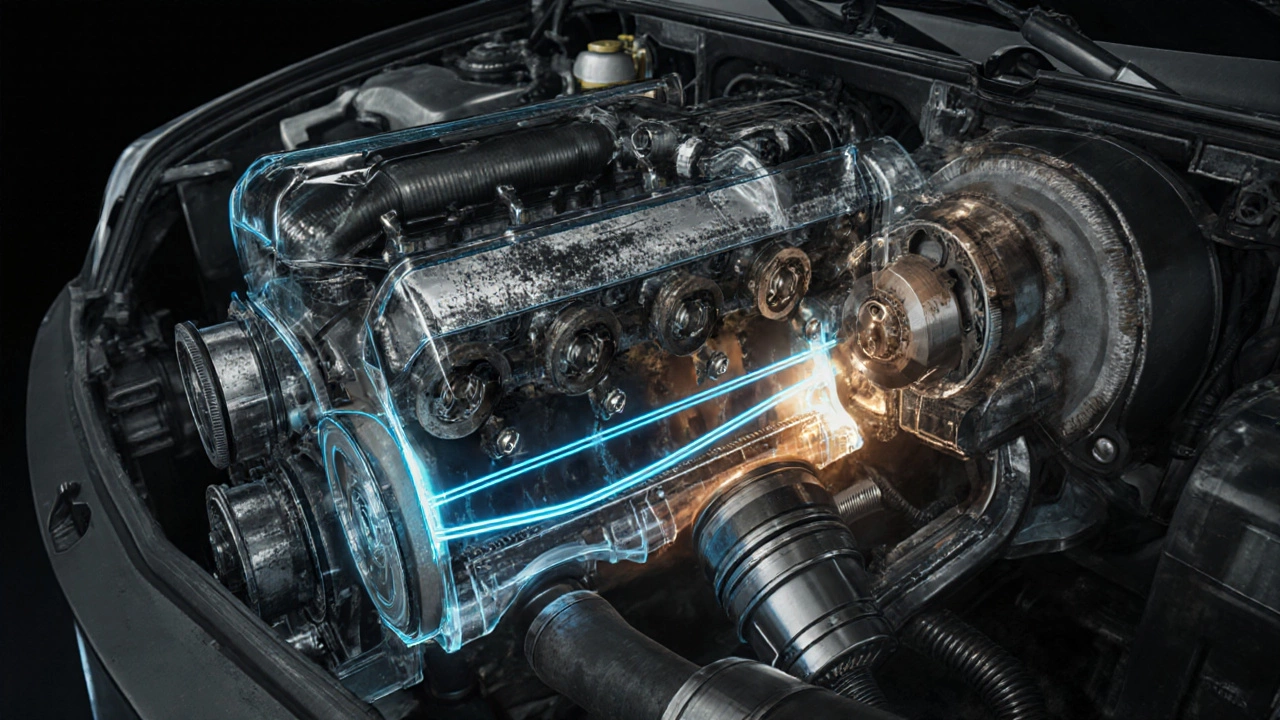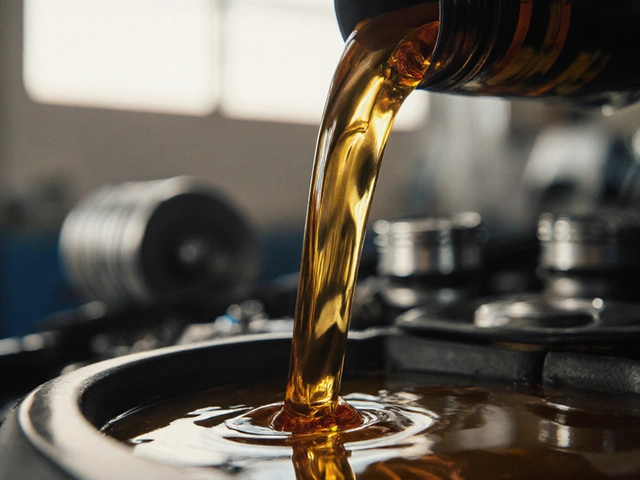Oil Change Interval Calculator
Personalized Oil Change Calculator
Most car manuals say to change your oil every 5,000 to 7,500 miles. But if you’ve ever stretched that to 6,000, 8,000, or even 10,000 miles, you’ve probably wondered: what happens if you go over 5000 miles between oil changes? The answer isn’t just "it’s bad." It’s more specific, more dangerous, and way more expensive than most drivers realize.
Your engine oil isn’t just dirty-it’s broken down
Engine oil doesn’t just collect dirt. It’s a complex chemical cocktail designed to lubricate, cool, and clean your engine. Over time, heat and pressure break those molecules apart. After 5,000 miles, especially if you’re driving in stop-and-go traffic, towing, or in extreme temperatures, the oil loses its ability to flow properly. That’s called viscosity breakdown. When oil gets too thin, it can’t form a protective film between moving parts. When it gets too thick from contamination, it won’t reach the tiny bearings and valves that need it most.
By 7,000 miles, synthetic oil may still look clean, but its additives-like detergents and anti-wear agents-are already 60-70% depleted. That means sludge starts forming. Sludge is gunk that clogs oil passages, blocks the oil filter, and sticks to pistons. Once it builds up, it’s not something a simple oil change can fix.
Increased friction = more wear, faster
Every time your engine runs, metal parts grind against each other. Oil is the only thing keeping them from scraping raw. When oil degrades, friction spikes. That’s not just theory. A 2023 study by the Society of Automotive Engineers found that engines running past 8,000 miles between oil changes showed 30% more wear on camshafts and valve lifters compared to those changed at 5,000 miles.
That wear doesn’t show up right away. You won’t hear knocking or smell burning. But over months or years, those tiny scratches add up. Bearings wear thin. Pistons lose their seal. Compression drops. Your engine starts using more oil, burning it, and losing power. That’s how you go from "needs an oil change" to "needs a rebuilt engine."
The oil filter can’t keep up
Most oil filters are designed to handle contaminants for about 5,000 to 7,500 miles. Push past that, and the filter becomes overloaded. It starts bypassing unfiltered oil directly into the engine. That’s not a myth-it’s built into the design. Filters have a bypass valve that opens when pressure gets too high. If the filter is clogged with sludge and metal particles, that valve opens. And suddenly, your engine is running on dirty oil with no protection at all.
Think of it like a water filter in your kitchen. If you never replace it, the water still flows-but it’s full of rust and sediment. Your engine doesn’t get a warning light for this. It just slowly starts to die.

Engine overheating is a real risk
Oil isn’t just for lubrication. It’s also a coolant. In modern engines, up to 40% of heat from the pistons is carried away by oil. When oil breaks down, it loses its ability to absorb and transfer heat. That means hot spots form inside the engine. Cylinder heads warp. Head gaskets blow. Timing chains stretch. Turbochargers seize.
One mechanic in Ohio told me about a 2018 Honda Civic that came in with no oil pressure. Owner said he’d gone 12,000 miles between changes. The turbocharger was completely seized. The oil passages were clogged with carbon chunks. The repair bill? $4,200. A simple oil change at 5,000 miles would’ve cost $60.
Warranty and resale value take a hit
If your car is under warranty, going beyond the manufacturer’s recommended interval can void coverage for engine-related claims. Manufacturers don’t just pick 5,000 miles out of thin air. They test engines under real-world conditions. If you skip oil changes, and your engine fails at 60,000 miles, the dealer can deny your claim based on maintenance records.
And when it comes time to sell? Buyers check service history. A car with oil changes every 5,000 miles looks cared for. A car with gaps or vague entries looks neglected. You could lose $2,000 to $5,000 in resale value just because you stretched your oil changes.

What about synthetic oil? Can I really go longer?
Synthetic oil lasts longer than conventional oil. But "longer" doesn’t mean "indefinitely." Even full synthetic oils degrade under heat and stress. Most automakers now recommend 7,500 to 10,000 miles for synthetics-but only if you’re driving under normal conditions. If you drive in heavy traffic, haul heavy loads, or live in a place with extreme heat or cold, you’re still better off sticking to 5,000 to 6,000 miles.
And here’s the catch: your car’s oil life monitor isn’t magic. It estimates based on driving patterns, not actual oil quality. If you drive mostly highway miles, it might say you’ve got 20% life left. But if you do a lot of short trips, the oil is already cooked. Don’t trust the monitor blindly. Check your manual. Track your miles. Change the oil when it says to.
Signs you’ve waited too long
You won’t always know until it’s too late. But here are red flags that mean you’ve pushed it too far:
- Engine knocking or ticking noises-especially when cold
- Oil smell inside the cabin
- Check engine light with codes like P0011 or P0016 (camshaft timing issues)
- Excessive exhaust smoke (blue or gray)
- Low oil pressure warning-even after topping off
If you see any of these, don’t wait. Get the oil changed immediately-and ask for a compression test. You might be looking at hundreds, or thousands, in repairs.
What should you do instead?
Follow your owner’s manual. If it says 5,000 miles, change it at 5,000. If it says 7,500, stick to that. But if you drive hard, drive in bad conditions, or just want to protect your investment, change it every 5,000 miles. It’s cheap insurance.
Set a reminder on your phone. Write it on your calendar. Put a sticky note on your dashboard. Make it automatic. The cost of an oil change is less than a tank of gas. The cost of ignoring it? A new engine.
Don’t gamble with your car’s heart. Oil isn’t a suggestion. It’s the lifeline.
Can I really go 10,000 miles with synthetic oil?
Some manufacturers say yes, but only if you drive under ideal conditions-mostly highway miles, no towing, no extreme heat or cold. If you drive in stop-and-go traffic, haul heavy loads, or live in a place with harsh winters, 10,000 miles is too long. Most mechanics recommend sticking to 7,500 miles even with synthetic oil for maximum protection.
Will my car warn me if the oil is too old?
Most modern cars have an oil life monitor, but it’s not a lab test. It estimates oil life based on engine temperature, RPM, and driving time-not actual oil quality. If you drive short trips often, the oil degrades faster than the system assumes. Always check your manual and don’t rely solely on the dashboard light.
Does going over 5,000 miles hurt gas mileage?
Yes. Thick, dirty oil increases internal engine friction. That forces the engine to work harder, burning more fuel. Studies show fuel economy can drop by 1-3% after 7,000 miles without an oil change. Over a year, that adds up to $100-$200 in extra gas costs.
Can I just top off the oil instead of changing it?
No. Topping off adds fresh oil to old, contaminated oil. It doesn’t remove sludge, metal particles, or degraded additives. You’re just diluting the problem. The oil still needs to be fully drained and replaced to protect your engine.
What’s the worst that can happen if I skip oil changes?
Complete engine failure. Sludge can block oil passages, causing bearings to seize. Pistons can scuff or crack. Valves can stick. Turbos can burn out. Repair costs range from $2,000 to over $8,000. In many cases, replacing the engine is cheaper than fixing it. A $60 oil change could have prevented it all.
If you’ve gone past 5,000 miles already, don’t panic. Change the oil now. Then set a reminder for the next one. Your engine won’t thank you today-but it’ll thank you for years to come.

